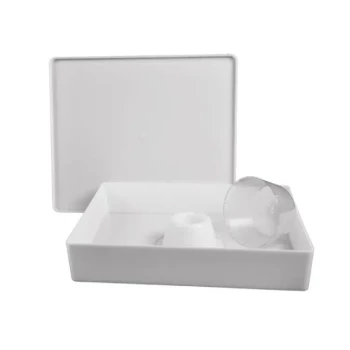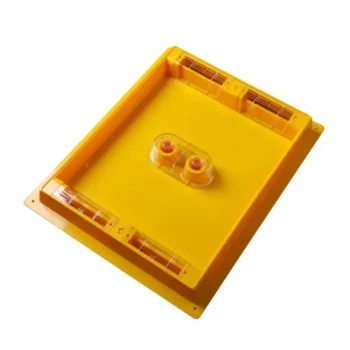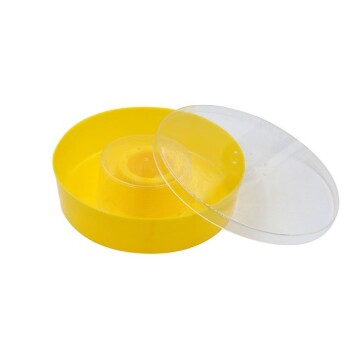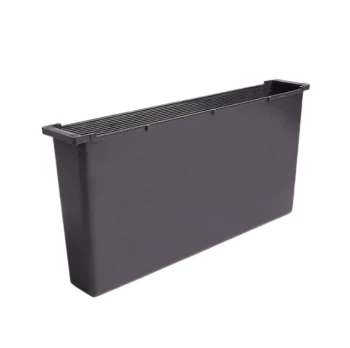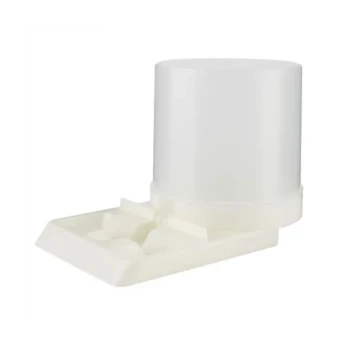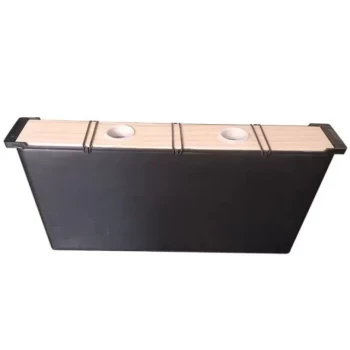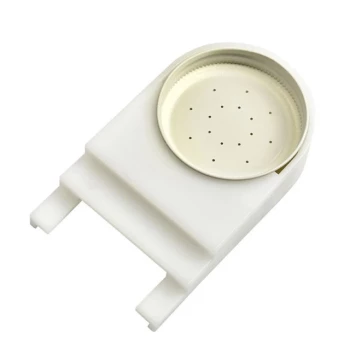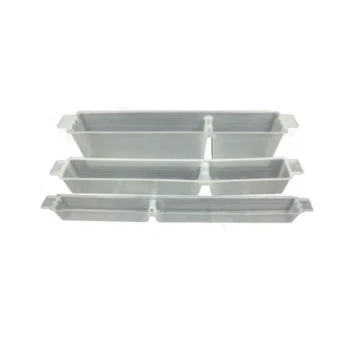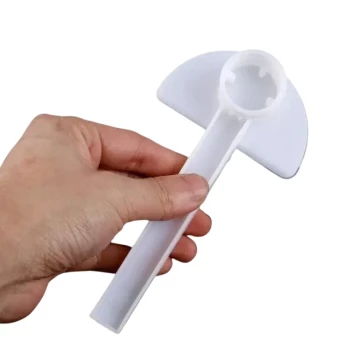A top feeder is an external feeding system that sits on the uppermost box of a beehive. It is essentially a shallow box containing a reservoir designed to hold a large volume of sugar syrup, allowing beekeepers to feed a colony with minimal disturbance. Bees access the syrup from below through a protected opening, often covered with mesh or hardware cloth to prevent them from drowning.
The primary value of a top feeder lies in its large capacity and ease of use. It allows a beekeeper to provide a significant amount of food with minimal hive intrusion, making it a highly efficient tool for preparing colonies for winter or stimulating rapid growth in the spring.

How a Top Feeder Works
A top feeder's design is simple but effective, centered on providing easy access for bees while protecting the food source and the colony.
The Basic Design
Most top feeders consist of a shallow box with an integrated reservoir for the syrup. A central, protected channel or screen allows bees to climb up from the hive box below and access the food without falling into the main liquid compartment.
This design keeps the syrup contained within the hive's structure, protecting it from sun, rain, and other environmental factors.
Installation and Use
To use a top feeder, the beekeeper removes the outer and inner covers of the hive. The feeder is placed directly on top of the uppermost hive box.
An empty hive box is then placed around the feeder to enclose it, and the hive's covers are placed on top of this empty box. This shields the feeder and prevents other insects from accessing the syrup.
Why It Protects the Colony
By containing the food source entirely within the hive, top feeders drastically reduce the risk of robbing. Robbing occurs when bees from other colonies (or wasps) discover a food source and attempt to steal it, which can lead to a devastating hive conflict.
Entrance feeders, by contrast, place the food source at the front door of the hive, sending a clear signal to nearby foragers and pests.
Key Advantages of a Top Feeder
Beekeepers often choose top feeders for three primary reasons that directly impact colony health and management efficiency.
Large Syrup Capacity
Top feeders can hold one to four gallons of syrup, far more than other common types like entrance or frame feeders. This large volume means the beekeeper can feed the colony less frequently, saving time and labor.
This is especially critical in the fall when a colony needs to store vast amounts of food for the winter.
Minimal Hive Disturbance
Refilling a top feeder is a quiet and minimally invasive process. The beekeeper simply removes the top covers, pours in more syrup, and closes the hive back up.
There is no need to "break open" the hive or remove frames, which keeps the bees calm and maintains the temperature and humidity of the brood nest.
Reduced Robbing and Pests
Because the syrup is not exposed externally, a top feeder is the best option for preventing robbing. The scent of the syrup is largely contained, making it difficult for outside bees or yellow jackets to locate.
Understanding the Trade-offs and Risks
While highly effective, top feeders are not without potential downsides. Understanding these trade-offs is key to using them correctly.
The Risk of Drowning
If a top feeder is poorly designed or maintained, bees can find their way into the main syrup reservoir and drown. It is crucial to select models with "bee tight" hardware cloth or well-designed float systems that give bees a safe surface from which to feed.
Potential for Chilling the Brood
In cooler climates or during early spring, placing a large, cold volume of syrup directly over the brood nest can potentially chill the developing bees. This is less of a concern in warm weather but is something to be aware of during transitional seasons.
Comparison to Other Feeder Types
Entrance feeders are simple and allow easy monitoring of syrup levels, but their small capacity and high risk of encouraging robbing make them unsuitable for major feeding.
Frame feeders, also known as division board feeders, sit inside the hive in place of a frame. They are good at preventing robbing but require opening the hive for refills and reduce the space available for brood or honey.
Making the Right Choice for Your Goal
The best feeder depends entirely on your specific objective for the colony at that moment.
- If your primary focus is rapid feeding for winter preparation: The top feeder's large capacity is the most efficient and effective choice.
- If your primary focus is stimulating a small, new colony: A smaller frame feeder or even a carefully monitored entrance feeder may be more appropriate to avoid overwhelming them.
- If your primary focus is convenience and minimizing hive disturbance: The top feeder is the clear winner, as it can be refilled quickly without exposing the colony.
Ultimately, choosing the right tool is about understanding your colony's needs and the distinct advantages each feeder design offers.
Summary Table:
| Feature | Benefit |
|---|---|
| Large Capacity (1-4 gallons) | Reduces refill frequency, ideal for winter preparation. |
| Internal Hive Placement | Minimizes disturbance and significantly reduces robbing. |
| Protected Access | Prevents bees from drowning with screens or floats. |
| Weather Protection | Keeps syrup safe from sun and rain within the hive structure. |
Equip Your Apiary for Success with HONESTBEE
As a trusted supplier for commercial apiaries and beekeeping equipment distributors, HONESTBEE provides the durable, high-capacity top feeders and other essential supplies you need to manage your colonies efficiently. Our wholesale-focused operations ensure you get the reliable equipment required for large-scale feeding programs, helping you maximize colony health and honey production.
Contact HONESTBEE today to discuss your wholesale needs and discover how our beekeeping solutions can support your business growth.
Visual Guide
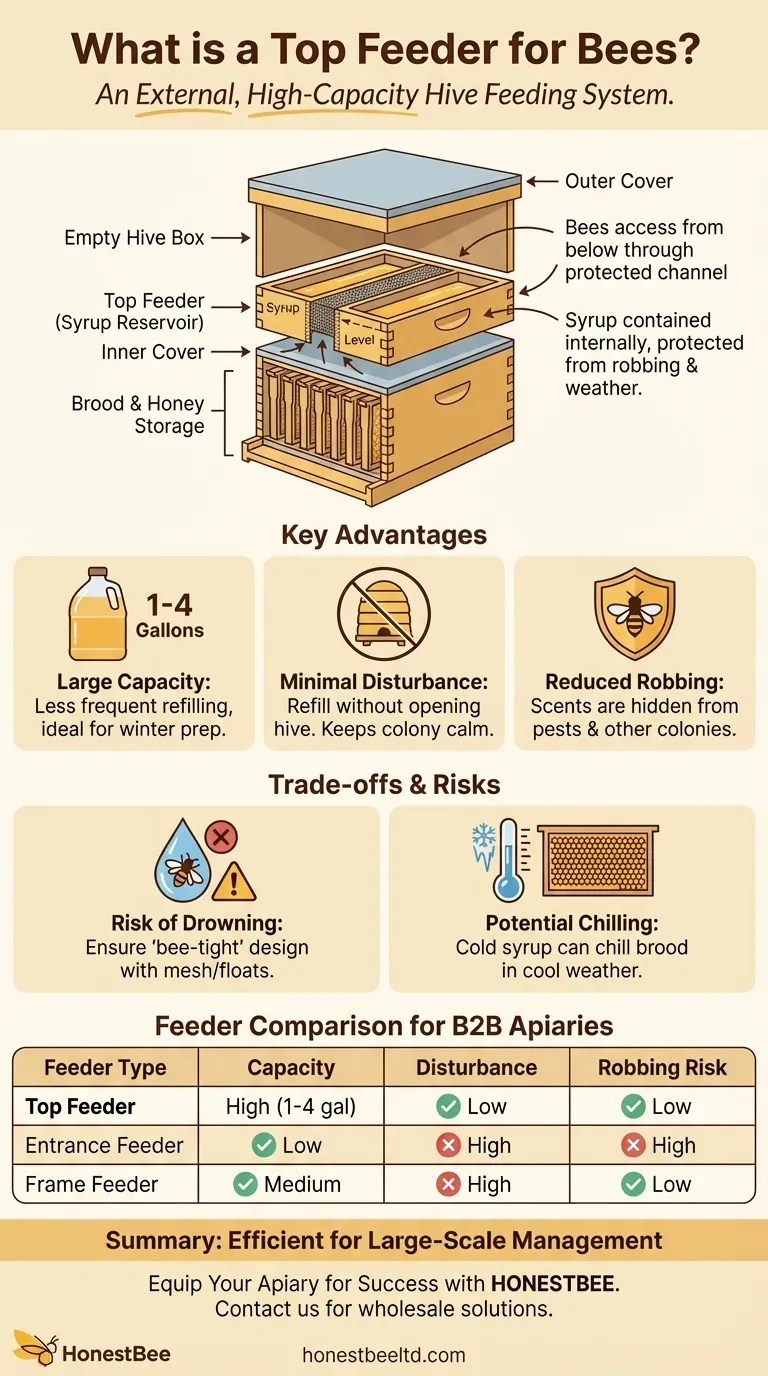
Related Products
- HONESTBEE Professional Hive Top Bee Feeder Feeding Solution
- Professional Hive Top Bee Feeder for Beekeeping
- HONESTBEE Round Hive Top Bee Feeder for Syrup
- HONESTBEE Advanced Ergonomic Stainless Steel Hive Tool for Beekeeping
- Professional In-Hive Bee Feeder HONESTBEE Frame for Beekeeping
People Also Ask
- What are the advantages of hive top feeders? Maximize Feeding Efficiency for Your Apiary
- What safety features are included in top feeders? A Guide to Drowning Prevention and Hive Safety
- Do I need an inner cover with a hive top feeder? Optimize Your Hive Setup for Healthy Bees
- How is the plywood floor fitted into the hive-top feeder? Ensure Longevity with a Floating Floor Design
- What is the best way to top feed bees? A Safe, High-Volume Feeding Solution for Your Apiary
